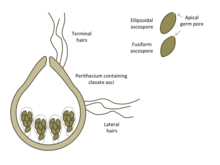Chaetomium
Chaetomium is a genus of fungi in the Chaetomiaceae family. It is a dematiaceous (dark-walled) mold normally found in soil, air, cellulose and plant debris. According to the Dictionary of the Fungi (10th edition, 2008), there are about 95 species in the widespread genus.[1]
| Chaetomium | |
|---|---|
_perithecium_40X.png) | |
| A Chaetomium perithecium | |
| Scientific classification | |
| Kingdom: | |
| Division: | |
| Class: | |
| Order: | |
| Family: | |
| Genus: | Chaetomium Kunze (1817) |
| Type species | |
| Chaetomium globosum Kunze ex Fr. (1829) | |
| Species | |
|
~95 | |
_ascospores_160X_(2).png)
In 1817 Gustav Kunze established the genus Chaetomium (the plume of the helmet)[2] to classify the species C. globosum and C. elatum. No further contributions to the genus were made until 1837 when the publication of Corda described its characteristic asci in his work, Icones Fungorum Hucusque Cognitorum.[3] In 1915, Arthur Houston Chivers produced a complete monographic treatment of the genus, recognizing only 28 of the described 114 species.[4]

Members of this genus typically have superficial, ostiolar perithecia, covered in hairs. Asci are often clavate and evanescent, bearing eight spores. Ascospores are usually lemon-shaped, commonly colored olive-brown. Mycelia often grows in conglomerate masses that resemble ropes.[5]
As well as being a contaminant, Chaetomium spp. are also encountered as causative agents of infections in humans. Many cases cause type 1 allergic reactions and infections. A few cases of fatal deep infections due to Chaetomium atrobrunneum have been reported in the immunocompromised people. Other clinical syndromes include brain abscess, peritonitis, and onychomycosis.
Selected species
- Chaetomium atrobrunneum
- Chaetomium carinthiacum
- Chaetomium cupreum
- Chaetomium cellulolyticum
- Chaetomium elatum
- Chaetomium funicola
- Chaetomium globosum
- Chaetomium grande
- Chaetomium interruptum
- Chaetomium iranianum
- Chaetomium jatrophae
- Chaetomium megalocarpum
- Chaetomium perlucidum
- Chaetomium rectangulare
- Chaetomium strumarium
- Chaetomium subspirale
- Chaetomium thermophilum
- Chaetomium truncatulum
- Chaetomium olivaceum
- Chaetomium undulatulum
References
- Kirk PM, Cannon PF, Minter DW, Stalpers JA (2008). Dictionary of the Fungi (10th ed.). Wallingford, UK: CABI. p. 131. ISBN 978-0-85199-826-8.
- Ames, L.M (1961). A Monograph of the Chaetomiaceae. 3301 Lehre Germany: Verlag von J.Cramer. pp. 2, 3, 9, 21.CS1 maint: location (link)
- Ames, L. M. (1949-11-01). "New Cellulose Destroying Fungi Isolated from Military Material and Equipment". Mycologia. 41 (6): 637–648. doi:10.2307/3755020. JSTOR 3755020.
- Chivers, Arthur Houston (1915). Details - A monograph of the genera Chaetomium and Ascotricha. - Biodiversity Heritage Library. doi:10.5962/bhl.title.97551.
- Chivers, A. H. (1915). "A monograph of the genera Chaetomium and Ascotricha". Mem. Torrey Bot. Club 14: 155-240.